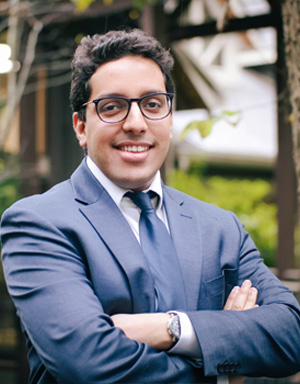Active vs. Passive ETFs
While passive investing is a popular strategy among ETF investors, it's not the only strategy. There are also active ETFs that do not follow an index; rather they rely on manager picks for a particular theme.
Join us as we discuss further.
About The Speakers
 Moustapha Mounah, CFA
Moustapha Mounah, CFA
Research Analyst
 Neil Craft
Neil Craft
Client Relationship Manager
Moustapha Mounah: I’m doing well, Neil, thanks for having me.
Neil Craft: Of course, of course. It's our pleasure. Moustapha, for our listeners, holds his MBA. He is an energy risk professional, as well as a CFA charter holder. We're very fortunate to have him on our James' research team, as well as on our show here today.
Today, we're going to get into a discussion talking about some of the differences between active and passive ETF investing. Mo, I think it's an important place to start for our listeners just to provide a brief definition on what is an ETF?
Moustapha Mounah: Sure, an Exchange Traded Fund or ETF for short, is a type of securities that a tax and index, sector, commodity or other assets, but which can be purchased or sold on a stock exchange the same way we do for a regular stock. So an ETF can be structured to track anything from the price of an individual commodity, to a large diverse collection of securities, and additional to traditional ETF’s, are available in hundreds of varieties tracking almost every index out there. There are a few benefits; one, a low turnover, low cost, and a broad diversification with a very low expense ratio.
Neil Craft: Excellent. Well thank you for some of that background there Mo, I think ETF investing started from somewhat of a passive approach. Can you may be shed some light on what that looks like?
Moustapha Mounah: Sure. Initially, ETF’s started as usually passive, following an index. For example, following the S&P 500 company’s returns by investing in all of the 500 names in the index; and that would get you to average returns. No out-performance or under-performance, just where the market or a sector returns it in a particular investment time horizon. Scenario one cannot invest directly in an index. Buying an ETF is a way to gain exposure to the index.
Neil Craft: Okay, now I'm sure there's probably multiple theories or perhaps some debate on what works best. Talking about a passive approach or an active approach to ETF investing, what does an active approach look like?
Moustapha Mounah: While passive investing is a popular strategy among ETF investors, it's not the only strategy. There are also active ETF’s that do not follow an index, rather they rely on manager picks for a particular theme. To give you guys an example, there is an ETF that tried to capture the work-from-home theme by investing in companies that benefited from us working remotely during the COVID pandemic.
Neil Craft: Interesting. Interesting. So perhaps somewhat of a silver lining coming out of 2020. Yeah. Mo, what would be a simple way that we all can be more active in our approach to using ETFs?
Moustapha Mounah: Well I want to, can they invest in thematic ETF’s?
Neil Craft: Okay. Now, sorry to cut you off. What's a thematic ETF?
Moustapha Mounah: Yeah. An example of thematic investing is if you think online e-commerce is here to stay and would survive for years to come, a good way to actively capture that theme is to invest in an ETF that has a basket of companies involved in that area. And to just answer your question, thematic is if all companies within the ETF share the same theme, or they're going to benefit from the same trend going forward. So those are two examples, work-from-home or the e-commerce, and there's a lot of other themes that include say new drugs that’ve got to cure cancer. For example, there are some ETF’s that like to track the companies that do that kind of research. The benefit of doing these, instead of picking a single stock from these baskets, is that you minimize the risk of picking a loser by increasing your diversification. And this is of particular importance if the theme is still very new, as the risk is usually high.
Neil Craft: Okay. So in this sense, we're trying to research potential trends that we're going to see in the economy, and then there would be a themed ETF kind of born out of that?
Moustapha Mounah: You got it. Exactly.
Neil Craft: That makes sense. Mo, what are we doing at James Investment to try and take advantage of opportunities in the market through active ETF investing?
Moustapha Mounah: We are actively using ETF’s to time the market or to do a sector rotation. For example, if our macro research indicates that the economy is about to have extraordinary growth, we would overweight cyclical sectors that are more exposed to the real economy such as industrials, materials, energy, financials using the actual S&P 500 sector ETF’s as a way to time them off and throw it to the sector early and fast. While our research team picks the individual stocks in these sectors, we used this approach last November when the vaccine first broke out, and it has worked very well.
Neil Craft: Okay. And now how about on the downside?
Moustapha Mounah: The additional diversification of ETF’s helps in the downside, and it has the potential to make the portfolio drop less than its benchmark during a downturn. But again, there is no guarantee for that, but the additional diversification is a plus to the traditional structure of the portfolio.
Neil Craft: Okay. So Mo as we near the end here, would you mind kind of summing up how James investment is actively using ETF’s for our clients?
Moustapha Mounah: Sure Neil. In some, you may see ETF’s along with stocks in your portfolio here at James, but these are for active reasons. Either trying to time the market by increasing equity levels quickly using, for example, the small cap ETF’s or large cap ETF’s, or also by tilting to a particular style; value versus growth or low volatility versus high volatility. Stocks, depending on what the regime are we entering into and what the research team is predicting.
Another reason will be if we are planning to execute on a research call for a sector that we believe may do well in the near future, by investing in that and that sector’s particular ETF. To find that reason would be to actively invest in an emerging theme, as we already talked about, in the economy or in markets that our research team again has explored, studied in depth and the Investment Committee has approved.
Neil Craft: Okay, well, Mo, thank you for your time and all of your research in this area and sharing it with our listeners.
Moustapha Mounah: Sure. It's my pleasure. And thanks for having me and I hope the information was useful for our listeners.
Neil Craft: If you have any questions about ETF’s and/or how they may fit into your portfolio, visit us at www.jamesinvestment.com for more information, and be sure to join us next month as we provide a mid-year update to our Economic Outlook.
James Investment: Your Future, Our Purpose.
Active Management: implies that a professional money manager or a team of professionals is tracking the performance of a client's investment portfolio and regularly making buy, hold, and sell decisions about the assets in it.
Passive Management: results are achieved by buying assets that mirror a particular market index or indexes and holding them long-term, ignoring the day-to-day fluctuations of the markets.
The S&P 500 Index: or the Standard & Poor's 500 Index, is a market-capitalization-weighted index of the 500 largest publicly-traded companies in the U.S.
Recent Podcasts
Social Security & Cost of Living Adjustment
1st Quarter Update - Economic Outlook 2022
3rd Quarter Update - Economic Outlook 2021
Understanding Risks In Cryptocurrency
2nd Quarter Update - 2021 Economic Outlook
1st Quarter Update - 2021 Economic Outlook
Balanced
Typical Allocation Range
Equity: 40% - 70%
Fixed Income: 30% - 60%
Cash: 1% - 15%
The Balanced strategy has a target range of 40% - 70% in equities, with a mix of small, mid, and large capitalization stocks. We weight the stock exposure toward the most advantageous market capitalizations based on our research.
Sector analysis in an important part of our portfolio management process. Changes in sector weightings are made based on our analysis.
We believe that having the maximum flexibility to follow our research is the key to adding value to our clients' accounts.

